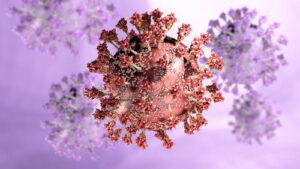
Overview:
It appears that COVID-19 has made a comeback. But not to worry. It is not like the epidemic we all experienced back in 2020. That said, we still need to be vigilant, as this virus is highly transmissible and has developed new variants, called “Nimbus” and “Stratus,” which are driving the increase in infected cases. While infections are rising rapidly across 40 states, these variants don’t appear to be more severe than the previous strains, and existing vaccines remain effective.
NB.1.8.1 “Nimbus” – The Dominant Strain
NB.1.8.1, nicknamed “Nimbus,” is now the dominant COVID variant in the United States, accounting for 43% of all cases as of the latest CDC data.
This variant:
-
- Has been reported in at least 31 U.S. states as of this writing, including California, New York, New Jersey, Maryland, Arizona, Illinois, Hawaii, Massachusetts, Ohio, Rhode Island, Vermont, Virginia, and Washington.
- Spreads 2.5 times more efficiently than the previously dominant LP.8.1 variant, due to mutations that help it bind more strongly to human cells.
XFG “Stratus” – The Rising Competitor
XFG, nicknamed “Stratus,” represents 22-23% of global COVID cases and is rapidly spreading alongside Nimbus. It has spread to at least 38 countries across Europe, the U.S., and Southeast Asia, and appears to have even stronger transmission ability than Nimbus in laboratory studies
Why These Variants Are Spreading So Fast
Both variants are descendants of the Omicron strain but have evolved specific advantages:
Nimbus (NB.1.8.1):
-
- Contains seven new mutations in its spike protein, plus 20 additional changes elsewhere
- Binds more strongly to ACE2 receptors that the virus uses to enter human cells
- Shows strong infectivity in lab-grown cells
Stratus (XFG):
-
- It is a hybrid of two earlier variants (LF.7 and LP.8.1.2)
- Contains four key mutations in its spike protein
- Demonstrates superior transmission ability in real-world settings
Geographic Impact and Numbers
United States
-
- 40 states are showing growing infections as of July 29, 2025
- At least 10 states are reporting “high” or “very high” viral levels in wastewater
- Bay Area COVID levels have exceeded winter peaks, with wastewater showing 55% increases over three weeks in California.
- COVID-related emergency room visits are increasing, particularly among young children, reaching the highest levels since March.
“Razor Blade Throat” (Nimbus)
The most notable symptom associated with Nimbus is a painful sore throat described as feeling like “razor blades” or “broken glass” in the throat.
Other symptoms include:
-
- Severe sore throat pain
- Nausea and vomiting
- Hoarse voice
- Standard COVID symptoms: fever, fatigue, muscle aches, cough
Hoarseness (Stratus)
Stratus infections are characterized by:
-
- Prominent hoarseness
- Dry coughs
- Sore throats
- Fever, muscle aches, and fatigue
Shorter Incubation Period
Both variants show a shortened incubation period of about 3 days, compared to 5-7 days in earlier pandemic phases. However, people may take longer to test positive, requiring multiple tests over several days.
Vaccine Effectiveness and Protection
Good news: Current vaccines remain effective against both variants. “Currently approved COVID-19 vaccines are expected to remain effective against symptomatic and severe disease,” from both Nimbus and Stratus.
However, there are some considerations to take into account:
-
- Nimbus shows a 1.5-1.6 fold reduction in antibody effectiveness compared to earlier variants
- Vaccine uptake remains low – only 21% of U.S. adults have received the 2024-2025 booster
- Recent policy changes have limited booster access to adults 65+ and those with certain health conditions
What Can Be Done?
Individual Protection Strategies
These are no different than previous guidelines outlined during the COVID-19 pandemic.
-
- Stay up to date on vaccinations – the 2024-2025 COVID vaccine targets KP.2 and protects against current strains
- Test frequently – use multiple tests if symptomatic, as variants may take longer to show positive results
- Wear N95 masks in crowded indoor spaces
- Practice basic hygiene – regular handwashing, covering coughs and sneezes
- Isolate when sick – these variants are highly transmissible
- Test after exposure – consider testing as early as 2 days after exposure if symptomatic
Public Health Response
-
- Enhanced surveillance through wastewater monitoring continues
- Updated vaccines for 2025-2026 targeting LP 8.1 are expected this fall
- Hospital capacity monitoring remains active as case numbers climb
The Reality Check
While these variants spread more easily, there’s no evidence they cause more severe illness than previous strains. “Current data do not indicate that this variant leads to more severe illness than other variants in circulation.”
However, increased transmission still matters because more infections mean more hospitalizations among vulnerable populations, even if the percentage requiring hospitalization remains the same.
Looking Ahead
This summer surge follows the pattern of COVID-19 having both winter and summer peaks. Cases typically rise during the summer travel season and indoor air conditioning use, creating conditions similar to winter’s indoor gatherings.
The emergence of these highly transmissible variants, combined with waning immunity and reduced precautions, has created perfect conditions for the current surge. While the variants aren’t more dangerous individually, their rapid spread means more people overall will experience COVID-19 this summer.
The key message: COVID-19 remains “a constant threat, but a manageable one,” as public health experts describe it. The tools we have – vaccines, testing, masking, and isolation – continue to work against these new variants.
